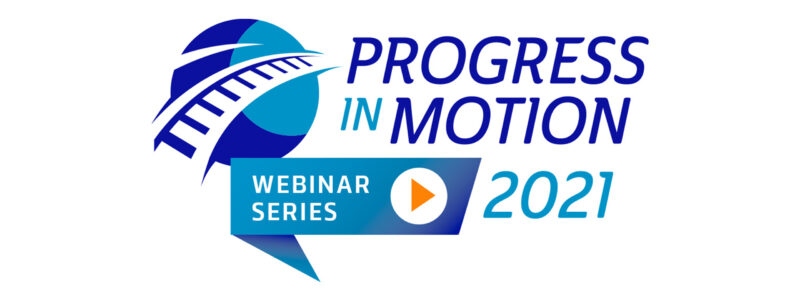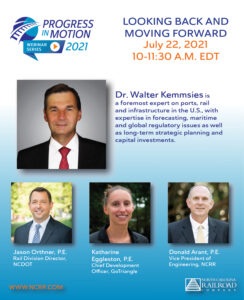
In our second webinar, we explored how we could leverage the railroad’s history and established routes for more effective and efficient freight and passenger movement in the future.
Dr. Walter Kemmsies, a foremost expert on ports, rail, and infrastructure, shared a few current trends to be aware of as context for our panel discussion. Jason Orthner, Director of NCDOT’s Rail Division, Katharine Eggleston, Chief Development Officer for GoTriangle, and Donald Arant, North Carolina Railroad’s Vice President-Engineering answered questions posed by Dr. Kemmsies.
Dr. Walter Kemmsies:
National rail and mass transit trends are currently positive – especially compared to long-haul trucking.
We don’t have enough roads and streets to support 230 million licensed drivers. We’re also facing a massive retirement of truck drivers with over half nearing retirement age. Therefore, it is trending cheaper to invest in rail and mass transit in the future.
Dr. Kemmsies asked our panelists how the historical location of the railroad influences growth today, how passenger routes like the Charlotte to Raleigh line have evolved, and what the investment strategy is for passenger and freight rail infrastructure statewide and locally moving forward.
Jason Orthner:
A lot of our cities and towns were created around the railroad. Part of the North Carolina Department of Transportation’s (NCDOT) vision is to utilize that reality and reintroduce rail service as a center point for passenger service. Eighty-six of our state’s 100 counties are touched by a railroad. Capitalizing on that could mean an increased ability for manufacturing and moving trucking off the road.
Creating more accessibility and mobility across the state is also a goal. The Charlotte and Raleigh passenger route is a great example of the demand that is present. Since 2005, ridership has increased by 500 percent.
The Rail Division at NCDOT is focused on three pillars of programs:
Katherine Eggleston:
The Triangle area is expected to grow by 1 million people and 800,000 jobs over the next 30 years. Economic engines of this region have always been focused on the rail line, and GoTriangle expects that to continue. A strategic continued investment for GoTriangle will be to use the existing corridor’s infrastructure to increase passenger and commuter services.
GoTriangle is working with us; Durham, Wake and Johnston Counties; the Research Triangle Foundation; and NCDOT to plan phase one of a commuter rail between Durham and Clayton. Nationally and locally, it’s been proven that mass transit solutions are needed to provide a reliable alternative for travelers. Commuter rail can deliver passengers to their destination safely and on time, regardless of traffic congestion. The commuter rail planning GoTriangle is currently focused on what would be part of a larger regional transit network, as well as an expanded bus service to connect rail stations to final destinations, such as RDU airport.
Donald Arant:
NCRR, constructed in the 1850s from Goldsboro to Charlotte, laid the groundwork for today’s passenger route. NCRR continues to invest in infrastructure improvements that support both freight and passenger in this shared use corridor. Infrastructure investments such as rail bridge replacements, grade separations, rail realignments to increase speeds, and capacity improvements for both freight and passenger needs.
For more details and questions from the audience, please watch the full webinar. For more conversations like this, watch our first webinar, where we discussed how the past year will change the future of railroading in our state.
